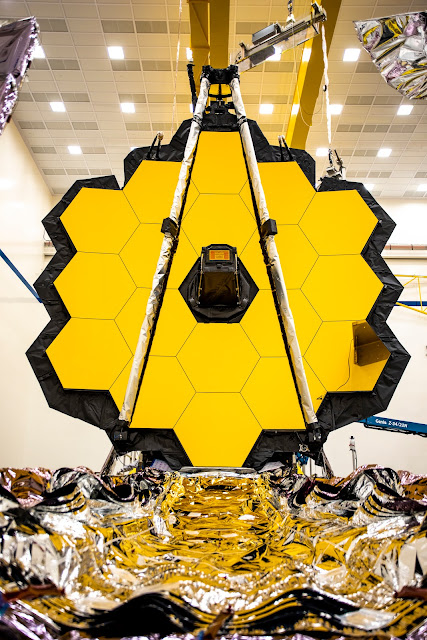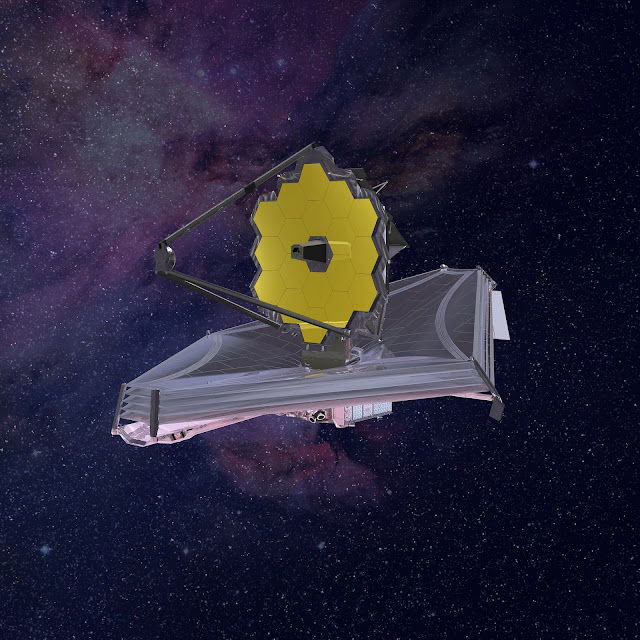© Mark Ollig
As 2021 comes to a close, we find ourselves envisioning what new technological discoveries and breakthroughs 2022 will reveal to us.
The future of technology and discovery is one of wonderment, and as its revelations unfold, we will shake our heads in amazement and appreciate being alive to witness it.
During the summer of 2022, we will begin to see revelations about our universe unfolding from the data obtained using 18 highly-polished gold-coated mirrors attached to the James Webb Space Telescope (JWST) aka Webb.
Launched Christmas Day, Webb will dramatically change our understanding of the universe.
“The promise of Webb is not what we know we will discover; it’s what we don’t yet understand or can’t yet fathom about our universe. I can’t wait to see what it uncovers,” said NASA Administrator Bill Nelson.
Dec. 25, about 12.5 hours after launch, Webb’s onboard thrusters fired to maneuver the spacecraft and alter its trajectory course. It will journey 1 million miles from Earth, settling into a halo orbit around the second Lagrange point, or Sun-Earth L2 point.
L2 is a point of gravitational balance and distance from Earth, offering Webb optimal cooling and improved communications due to reduced interference from the Sun’s radio emissions.
L2 is also a desirable location because it decreases the fuel required for a spacecraft to remain in orbit.
It will take the Webb spacecraft one month to reach L2. Once there, it will always stay on Earth's night side while it orbits around the Sun.
NASA states another advantage of this orbit is that Webb will always be at the exact general location relative to Earth.
Webb will be close enough to Earth for continuous communication through the Deep Space Network, an international array of giant antennas geographically located on our planet that NASA's Jet Propulsion Laboratory manages for deep space missions.
Another advantage of an L2 orbit allows Webb to be perpetually bathed in the sunshine to generate power via the solar array on the Sun-facing side of the spacecraft while providing an unobstructed view of deep space.
In addition, the orbital path Webb takes ensures it stays out of the shadows of both Earth and the Moon.
The gimbaled antenna assembly on the Webb includes a high-data-rate dish antenna that will send approximately 57.2 GBytes (gigabytes) of data back to Earth each day.
Some of the scientific instruments installed on the Webb telescope include cameras for taking pictures of astronomical objects.
Webb will use spectrographs to break light into colors of scientific analysis.
The Webb telescope will also use coronagraphs to block sunlight, allowing observation of planets.
Construction on the Webb telescope began in 2004, and over the last 17 years, there have been many breakthrough technologies and advances incorporated into Webb.
Some of these breakthroughs include lightweight deployable mirrors and advanced composite structures that align to millionths of millimeters and work at super-cold temperatures.
Webb employs large, ultra-sensitive infrared light detectors and micro-shutter devices with thousands of tiny windows, each the width of a human hair and programmable to be open or closed to enable spectroscopic measurement of hundreds of individual objects simultaneously.
Webb also contains a cryocooler that chills the mid-infrared detectors to the necessary temperature just a few degrees above absolute zero (-459.67 degrees Fahrenheit).
The scientific instruments aboard Webb will safely operate at temperatures from -380 to 260 degrees Fahrenheit.
Although it will only take one month for the Webb telescope to arrive at L2, it will be undergoing a six-month commissioning period, during which it fully deploys, cools down to operating temperatures, aligns its mirrors, and calibrates its instruments.
Routine science operations on Webb will begin during June 2022, as all 18 mirrors will be aligned, along with the final calibration of its scientific instruments and telescope.
Webb will give us a look back in time over 13.5 billion years, which is only a few hundred million years after “the big bang” theory which many astronomers and scientists say ignited the universe.
My question regarding this theory has always been, “What created the physical material leading to the energy that caused the big bang to ignite?”
Of course, who started the universe is justifiably related, but today is off-topic, so I will digress to the main subject.
The James Webb Space Telescope was designed to last five years, but is expected to be operational for 10 years.
Mikulski Archive for Space Telescopes (MAST) will store data from the Webb telescope at https://archive.stsci.edu, and is freely accessible to the scientific community and the general public.
MAST is part of the STScI (Space Telescope Science Institute) located in Baltimore, MD.
MAST also stores the Transiting Exoplanet Survey Satellite, Kepler, and Hubble space mission data.
The James Webb Space Telescope will use future technology to look billions of years into the past.
As we close out 2021, I’d like to express my appreciation to you for spending a few moments of your time each week reading this column.
Now, it is on to 2022.











